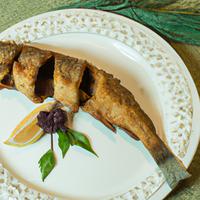
1 serving (150 grams) contains 250 calories, 20.0 grams of protein, 15.0 grams of fat, and 10.0 grams of carbohydrates.

Log this food in SnapCalorie

Nutrition Information
Calories |
396.8 | ||
|---|---|---|---|
% Daily Value* |
|||
| Total Fat | 23.8 g | 30% | |
| Saturated Fat | 4.8 g | 24% | |
| Polyunsaturated Fat | 0 g | ||
| Cholesterol | 111.1 mg | 37% | |
| Sodium | 634.9 mg | 27% | |
| Total Carbohydrates | 15.9 g | 5% | |
| Dietary Fiber | 0 g | 0% | |
| Sugars | 0 g | ||
| protein | 31.7 g | 63% | |
| Vitamin D | 317.5 mcg | 1587% | |
| Calcium | 47.6 mg | 3% | |
| Iron | 2.4 mg | 13% | |
| Potassium | 476.2 mg | 10% | |
* Percent Daily Values are based on a 2,000 calorie diet. Your daily values may be higher or lower depending on your calorie needs.
Food Attributes
Source of Calories
About Fried baracudda
Fried barracuda is a flavorful seafood dish popular in coastal cuisines worldwide, particularly in Caribbean and Southeast Asian cooking. This dish typically features fresh barracuda fillets seasoned with a blend of spices like garlic, paprika, and herbs, then coated in flour or breadcrumbs and shallow- or deep-fried until golden brown. Barracuda is a lean fish, rich in protein, omega-3 fatty acids, and essential vitamins like B12 and D. These nutrients support heart health, brain function, and energy metabolism. However, frying adds significant calories and fat, especially if the fish is deep-fried or paired with heavy sauces. Additionally, barracuda may carry higher mercury levels, so moderation is important, especially for children and pregnant individuals. Fried barracuda is typically enjoyed with fresh salads, steamed vegetables, or spicy dips to balance indulgence with nutrition.



